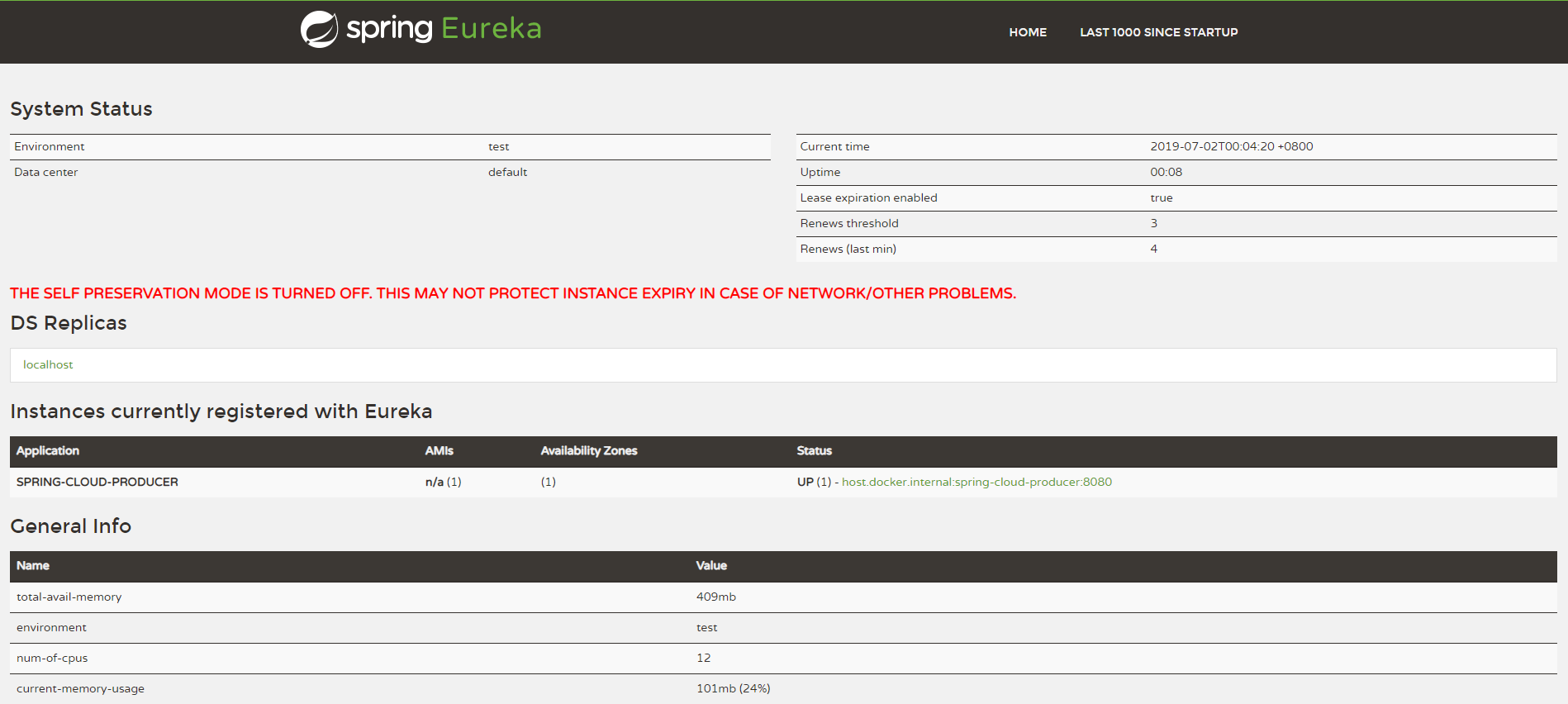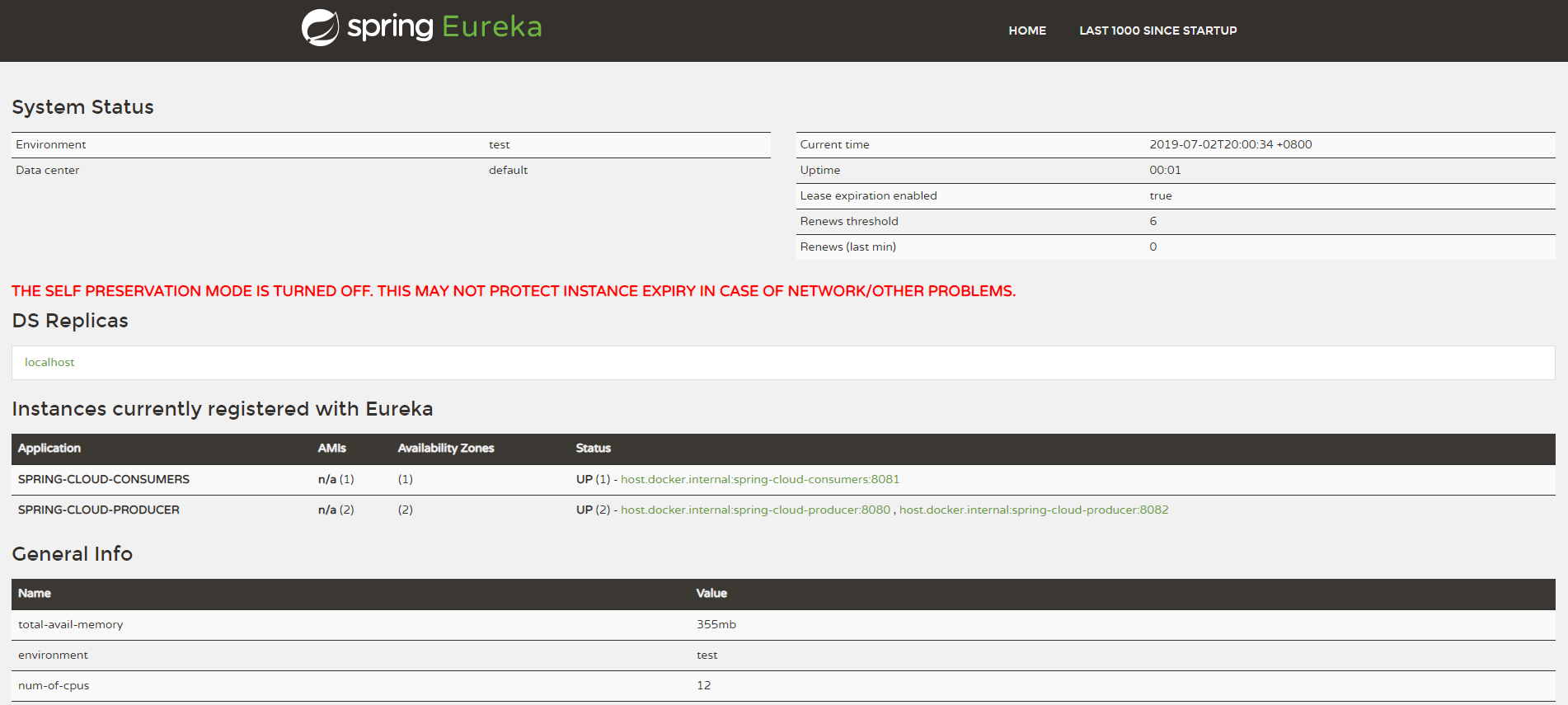Spring cloud series Tutorial Part 3: service provision and Feign call
Springboot: 2.1.6.RELEASE
SpringCloud: Greenwich.SR1
Unless otherwise specified, this series of tutorials adopts the above version
In the previous article, we introduced the construction of the registry, including the construction of the registry in the cluster environment. This article introduces how to use the registry to create a service provider and use a simple client to call the services provided by the server.
Three roles are required in this article, namely, the service provider, the service consumer, and the protagonist of the previous article - the registry Eureka (you can use the stand-alone version, and this example will also use the stand-alone version of Eureka).
The overall process is:
- Start the registration center Eureka first
- The provider that starts the service will provide the service and register the service with the registry Eureka
- Start the consumer of the service, find the service in the registry and complete the consumption
1. Service providers
1. pom.xml
<?xml version="1.0" encoding="UTF-8"?>
<project xmlns="http://maven.apache.org/POM/4.0.0" xmlns:xsi="http://www.w3.org/2001/XMLSchema-instance"
xsi:schemaLocation="http://maven.apache.org/POM/4.0.0 http://maven.apache.org/xsd/maven-4.0.0.xsd">
<modelVersion>4.0.0</modelVersion>
<parent>
<groupId>org.springframework.boot</groupId>
<artifactId>spring-boot-starter-parent</artifactId>
<version>2.1.6.RELEASE</version>
<relativePath/> <!-- lookup parent from repository -->
</parent>
<groupId>com.springcloud</groupId>
<artifactId>producer</artifactId>
<version>0.0.1-SNAPSHOT</version>
<name>producer</name>
<description>Demo project for Spring Boot</description>
<properties>
<java.version>1.8</java.version>
<spring-cloud.version>Greenwich.SR1</spring-cloud.version>
</properties>
<dependencies>
<dependency>
<groupId>org.springframework.boot</groupId>
<artifactId>spring-boot-starter-web</artifactId>
</dependency>
<dependency>
<groupId>org.springframework.cloud</groupId>
<artifactId>spring-cloud-starter-netflix-eureka-client</artifactId>
</dependency>
<dependency>
<groupId>org.springframework.boot</groupId>
<artifactId>spring-boot-starter-test</artifactId>
<scope>test</scope>
</dependency>
</dependencies>
<dependencyManagement>
<dependencies>
<dependency>
<groupId>org.springframework.cloud</groupId>
<artifactId>spring-cloud-dependencies</artifactId>
<version>${spring-cloud.version}</version>
<type>pom</type>
<scope>import</scope>
</dependency>
</dependencies>
</dependencyManagement>
<build>
<plugins>
<plugin>
<groupId>org.springframework.boot</groupId>
<artifactId>spring-boot-maven-plugin</artifactId>
</plugin>
</plugins>
</build>
</project>
2. Configuration file application yml
server:
port: 8080
spring:
application:
name: spring-cloud-producer
eureka:
client:
service-url:
defaultZone: http://localhost:8761/eureka/
3. Start class producerapplication java
Add @ EnableEurekaClient. If it is another registry, you can use the annotation @ EnableDiscoveryClient to register the service
package com.springcloud.producer;
import org.springframework.boot.SpringApplication;
import org.springframework.boot.autoconfigure.SpringBootApplication;
import org.springframework.cloud.netflix.eureka.EnableEurekaClient;
@SpringBootApplication
@EnableEurekaClient
public class ProducerApplication {
public static void main(String[] args) {
SpringApplication.run(ProducerApplication.class, args);
}
}
4. Controller
package com.springcloud.producer.controller;
import org.springframework.web.bind.annotation.RequestMapping;
import org.springframework.web.bind.annotation.RequestParam;
import org.springframework.web.bind.annotation.RestController;
/**
* Created with IntelliJ IDEA.
*
* @Date: 2019/7/2
* @Time: 0:02
* @email: inwsy@hotmail.com
* Description:
*/
@RestController
public class HelloController {
@RequestMapping("/hello")
public String hello(@RequestParam String name) {
return "hello "+name+",producer is ready";
}
}
First, you can start Eureka in the stand-alone version of the previous article, and then start the producer service provider we just wrote. After the startup is successful, visit the link http://localhost:8761/ , we can see that our service provider producer has successfully registered in the registry.

At this point, the service provider has been configured.
2. Service consumers
1. pom.xml
<?xml version="1.0" encoding="UTF-8"?>
<project xmlns="http://maven.apache.org/POM/4.0.0" xmlns:xsi="http://www.w3.org/2001/XMLSchema-instance"
xsi:schemaLocation="http://maven.apache.org/POM/4.0.0 http://maven.apache.org/xsd/maven-4.0.0.xsd">
<modelVersion>4.0.0</modelVersion>
<parent>
<groupId>org.springframework.boot</groupId>
<artifactId>spring-boot-starter-parent</artifactId>
<version>2.1.6.RELEASE</version>
<relativePath/> <!-- lookup parent from repository -->
</parent>
<groupId>com.springcloud</groupId>
<artifactId>consumers</artifactId>
<version>0.0.1-SNAPSHOT</version>
<name>consumers</name>
<description>Demo project for Spring Boot</description>
<properties>
<java.version>1.8</java.version>
<spring-cloud.version>Greenwich.SR1</spring-cloud.version>
</properties>
<dependencies>
<dependency>
<groupId>org.springframework.cloud</groupId>
<artifactId>spring-cloud-starter-netflix-eureka-client</artifactId>
</dependency>
<dependency>
<groupId>org.springframework.boot</groupId>
<artifactId>spring-boot-starter-web</artifactId>
</dependency>
<dependency>
<groupId>org.springframework.cloud</groupId>
<artifactId>spring-cloud-starter-openfeign</artifactId>
</dependency>
<dependency>
<groupId>org.springframework.boot</groupId>
<artifactId>spring-boot-starter-test</artifactId>
<scope>test</scope>
</dependency>
</dependencies>
<dependencyManagement>
<dependencies>
<dependency>
<groupId>org.springframework.cloud</groupId>
<artifactId>spring-cloud-dependencies</artifactId>
<version>${spring-cloud.version}</version>
<type>pom</type>
<scope>import</scope>
</dependency>
</dependencies>
</dependencyManagement>
<build>
<plugins>
<plugin>
<groupId>org.springframework.boot</groupId>
<artifactId>spring-boot-maven-plugin</artifactId>
</plugin>
</plugins>
</build>
</project>
Spring boot starter Web: this package is a general web development package, which contains spring web, spring webmvc and other packages
Spring Cloud starter openfeign: this package is the encapsulation of feign by Spring Cloud. Feign is a declarative Web service client. It supports feign's own annotations, JAX-RS annotations, and spring MVC annotations. Spring Cloud integrates Ribbon and Eureka to provide a load balanced http client when using feign.
2. Configuration file application yml
server:
port: 8081
spring:
application:
name: spring-cloud-consumers
eureka:
client:
service-url:
defaultZone: http://localhost:8761/eureka/
3. Start class consumersapplication java
As above, @ EnableEurekaClient is added. If it is another registry, the annotation @ EnableDiscoveryClient can be used to register the service
package com.springcloud.consumers;
import org.springframework.boot.SpringApplication;
import org.springframework.boot.autoconfigure.SpringBootApplication;
import org.springframework.cloud.netflix.eureka.EnableEurekaClient;
import org.springframework.cloud.openfeign.EnableFeignClients;
@SpringBootApplication
@EnableEurekaClient
@EnableFeignClients
public class ConsumersApplication {
public static void main(String[] args) {
SpringApplication.run(ConsumersApplication.class, args);
}
}
@EnableFeignClients: this annotation tells SpringBoot to scan the classes modified by @ FeignClient when starting. This annotation @ FeignClient will be used when making remote calls.
4. Feign remote call
Feign is a declarative Web Service client. Using feign can make it easier to write a Web Service client. Its use method is to define an interface and add annotations on it. At the same time, it also supports the annotations of JAX-RS standard. Feign also supports pluggable encoders and decoders. Spring Cloud encapsulates feign to support Spring MVC standard annotations and HttpMessageConverters. Feign can be used in combination with Eureka and Ribbon to support load balancing.
Create a remote interface
package com.springcloud.consumers.remote;
import org.springframework.cloud.openfeign.FeignClient;
import org.springframework.web.bind.annotation.RequestMapping;
import org.springframework.web.bind.annotation.RequestParam;
/**
* @Author: shiyao.wei
* @Date: 2019/7/2 11:14
* @Version: 1.0
* @Desc:
*/
@FeignClient(name= "spring-cloud-producer")
public interface HelloRemote {
@RequestMapping(value = "/hello")
String hello(@RequestParam(value = "name") String name);
}
- Name: remote service name, and spring application. Name the name of the configuration
- The method names and parameters in this class must be consistent with those in the contoller in the remote service
5. The web layer calls the remote interface Controller
package com.springcloud.consumers.controller;
import com.springcloud.consumers.remote.HelloRemote;
import org.springframework.beans.factory.annotation.Autowired;
import org.springframework.web.bind.annotation.PathVariable;
import org.springframework.web.bind.annotation.RequestMapping;
import org.springframework.web.bind.annotation.RestController;
/**
* @Author: shiyao.wei
* @Date: 2019/7/2 11:25
* @Version: 1.0
* @Desc:
*/
@RestController
public class HelloController {
@Autowired
HelloRemote helloRemote;
@RequestMapping("/hello/{name}")
public String index(@PathVariable("name") String name) {
return helloRemote.hello(name);
}
}
Now, the simplest example of service registration and invocation is completed.
3. Test
Simple call
Start eureka, producer and consumer in sequence
After successful startup, enter in the browser first http://localhost:8080/hello?name=springcloud
You can see that the page displays: hello springcloud, producer is ready
It proves that our producer has started normally and the services provided are normal
Next, we test the service consumer and enter in the browser: http://localhost:8081/hello/spring
You can see the page display: hello spring, producer is ready
It indicates that the client has successfully called the remote service hello through feign and returned the result to the browser.
load balancing
Copy the producer above, change the name to producer 2, and modify POM < name > < / name > in XML is producer 2. Modify the Controller:
package com.springcloud.producer.controller;
import org.springframework.web.bind.annotation.RequestMapping;
import org.springframework.web.bind.annotation.RequestParam;
import org.springframework.web.bind.annotation.RestController;
/**
* Created with IntelliJ IDEA.
*
* @Date: 2019/7/2
* @Time: 0:02
* @email: inwsy@hotmail.com
* Description:
*/
@RestController
public class HelloController {
@RequestMapping("/hello")
public String hello(@RequestParam String name) {
return "hello "+name+",producer2 is ready";
}
}
Modify application The YML configuration file startup port is 8082
Start the producer 2 we just copied. At this time, you can take a look at the registration center Eureka. We now have two producer services.

Then we will visit: http://localhost:8081/hello/spring
The first returned result: hello spring, producer is ready
The second return result: hello spring, producer 2 is ready
When the page is refreshed continuously, the two results will appear alternately, indicating that the registry provides the service load balancing function. When the number of services is increased to N, it will be found that the test results are the same, and the requests will be automatically polled to each server for processing.
Well, now you can package the code and throw it to Github. Welcome to Github:)
Series review
-
Learn from me spring cloud | Part 2: Registration Center Eureka
-
Learn from me spring cloud Chapter 3: service provision and Feign invocation
-
Learn from me spring cloud Chapter 5: fuse monitoring, Hystrix Dashboard and Turbine
-
Learn from me about spring cloud Chapter 6: Spring Cloud Config Github configuration center
-
Learn from me spring cloud Chapter 8: Spring Cloud Bus message bus
-
Learn from me spring cloud | Chapter 9: a preliminary study of Zuul, a service gateway
-
Learn from me spring cloud Chapter 10: Zuul advanced service gateway
-
Learn from me about spring cloud Chapter 12: a preliminary study of Spring Cloud Gateway
-
Learn from me spring cloud Chapter 13: Spring Cloud Gateway service and filter
-
Learn from me about spring cloud | Chapter 14: Advanced Application of Spring Cloud Gateway
-
Learn from me spring cloud Chapter 15: APM platform of micro service sword (I) Skywalking
-
Learn from me spring cloud | Chapter 16: APM platform of micro service sword (II) Pinpoint
-
Learn from me spring cloud Chapter 17: service gateway Zuul based on Apollo dynamic routing